The state of Georgia is biologically diverse. There are 268 native trees in its growing zones ranging from 6a in the north to 9a in the south! Here are 31 iconic trees native to Georgia — how many do you recognize?
1. Bald Cypress
The most iconic Georgia tree must be the swamp-loving bald cypress. This pyramidal beauty is a deciduous conifer with long branches and soft yellow-green needle foliage in spring that matures to orange-brown in fall alongside one-inch wide cones.
Bald cypress trees are instantly recognizable by the “knees” that rise from their roots. Botanists think this might be so they can gather oxygen. Whatever the reason, bald cypresses in Georgia cope with floods and drought across zones 4-10. It’s a tough and iconic 70-foot-tall Georgia tree with lots of personality.

Bald cypress trees cope with flood and droughts.
©Norm Lane/Shutterstock.com
2. Sweet Gum
One of Eastern America’s large deciduous trees is the narrow-trunked but round-crowned sweet gum. With star-shaped glossy green foliage in spring to summer and yellow, orange, and purple leaves in fall, this tree is unmistakable.
When they fall, it is possible to see the leaves’ branching patterns and rubbery corky twigs. In spring, sweet gum trees bloom clusters of yellow-green flowers, which mature into hard seed balls over winter and give it the common name “satin walnut.”
60-feet-tall aromatic sweet gum doesn’t like alkaline ground but thrives in acidic soils across zones 5-10. Its fall foliage is characteristic, so most folks recognize this iconic tree all year round.

American sweetgum turns bright orange and red during fall.
©iStock.com/sundry photography
3. White Basswood
Deciduous white basswood trees thrive in zones 2-8. They have rounded crowns of dark green oval leaves that turn yellow in fall, but it’s the bee-attracting flowers that are so distinctive. These tiny yellow flowers emit a strong fragrance, and they’re packed with honey reserves. Once pollinated by hungry bees, they mature into hard brown nuts.
White basswood’s furrowed, shiny gray trunk can reach 80 feet tall and develop a 50-foot-wide crown. It’s a huge Georgia state tree, sometimes called American linden or lime tree.

Basswood trees’ yellow flowers are attractive to pollinators.
©iStock.com/LeManna
4. Hazel Alder
Found close to streams, rivers, and springs in growing zones 4-9, hazel alders most often have multi-spreading trunks and a thick spreading crown.
It’s a fairly small 20-foot-tall tree with a smooth gray trunk, dark green ovate leaves, brown-yellow male catkins, and bright red upright female catkins in early April. In the fall, one-inch-long cylinder cones provide food for birds.
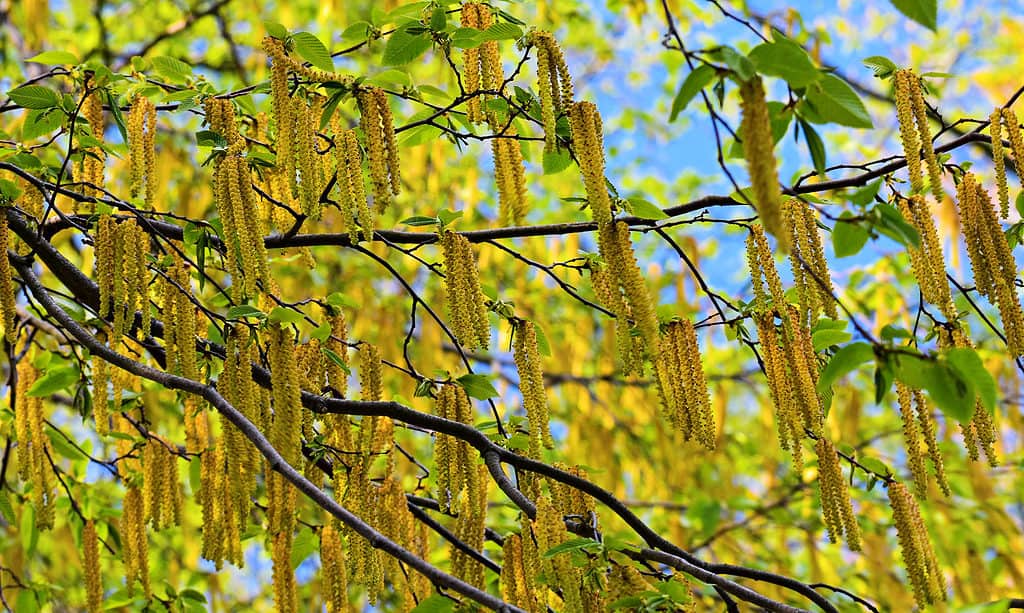
Hazel alder produces long yellow male catkins and bright red upright female catkins.
©Gabriela Beres/Shutterstock.com
5. Winged Sumac
Deciduous winged sumacs are fairly small trees that reach 15 feet tall and the same in spread. Their characteristic twisting trunks and open branching hold aloft glossy dark-green leaves and yellowy-green springtime flowers that mature to red pyramid-shaped fruits for winter.
Pollinating partners are required! You’ll often find both nearby on Georgia’s hilly slopes and prairie thickets throughout zones 5-11.

Winged sumac trees require both male and female plants to produce fruit.
©Kathy Clark/Shutterstock.com
6. Sugarberry
The Native American Comanche tribe would take sugarberry’s red summer berries and mash them up with animal fats to roast on a fire. This long-shelf life recipe saw them through a long, lean winter. Humans don’t eat sugarberries regularly these days, but birds adore them.
It’s a deciduous tree with deep green lance-shaped leaves that are paler beneath and a smooth, barely ridged dark gray trunk.
These trees prefer moist soil and flood plains or marshy areas in zones 7a to 8b but cope admirably with dry conditions too. Many folks call the sugarberry tree southern hackberry. They’re rarely seen outside the southern states.
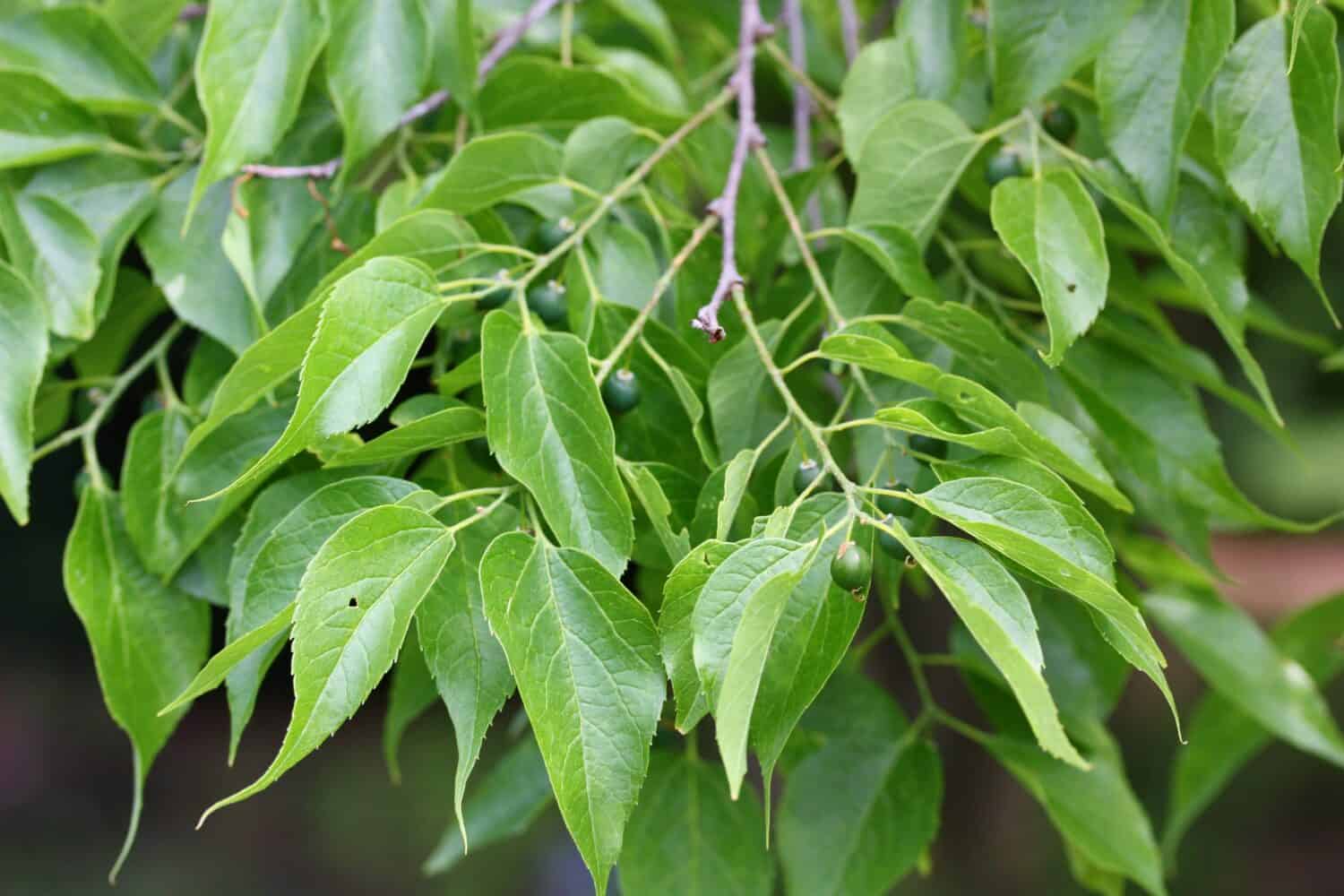
Native Americans roasted sugarberry fruits with animal fats.
©islavicek/Shutterstock.com
7. Florida Maple
20-60-feet-tall deciduous Florida maples have distinctive curly gray bark in winter and palmate 2-4 inch long green foliage in spring that matures to orange and red during fall.
These attractive Georgia natives are often grown as specimen trees because their flowers bloom early and attract early-waking pollinators. Plus children like to chase the winged samara fruits when they fall.
Florida maple trees grow in Georgia’s zones 6-9 and prefer acidic soil. Once established, they cope well with drought.
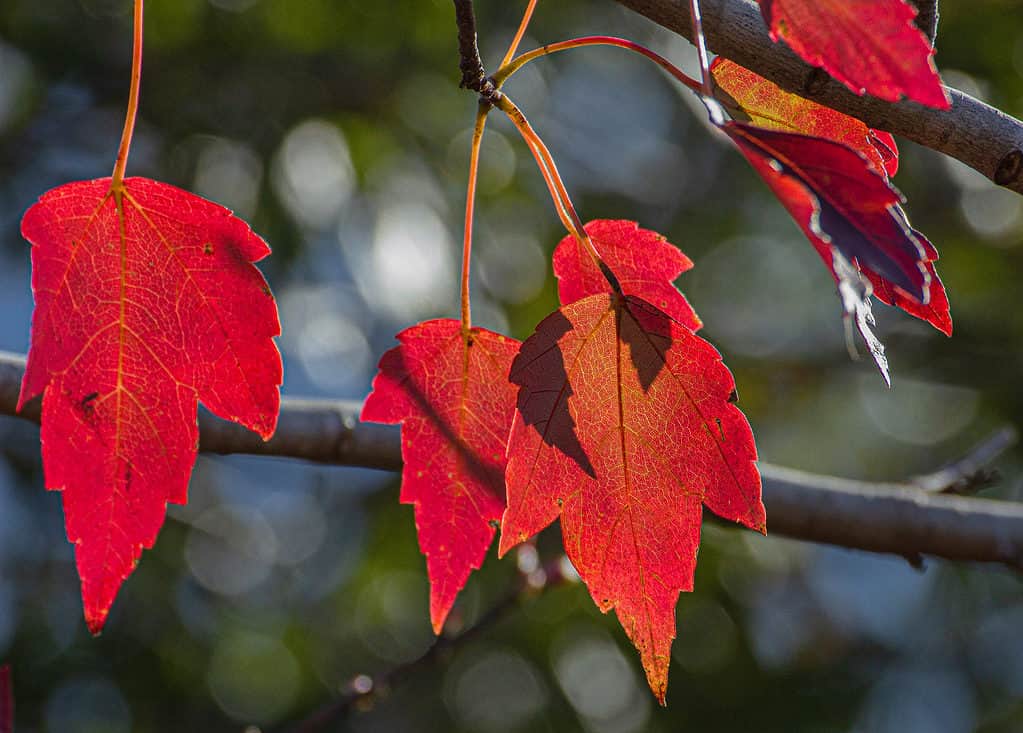
The Florida maple tree is known for its stunning fall colors.
©Ken Donaldson/Shutterstock.com
8. Cedar Pine
Cedar pine is often called the spruce pine in Georgia. It’s an evergreen pine that reaches 50 feet tall but is limited to zones 8a-9b in coastal zones, so it’s not a common sight across the state. However, it is iconic in coastal forests where its bent and twisted trunk often sags its branches to the soil and into streams.
This tree is a beauty with fine green needles and two-inch brown cones in fall. Its dark bark is smooth, and mature cedar pine trunks sometimes split to create distinctive flat ridges.

Cedar pine is also called spruce pine in Georgia.
©Alexander Denisenko/Shutterstock.com
9. Eastern Cottonwood
The towering eastern cottonwood tree is one of Georgia’s iconic trees. Its fast-growing nature means it can reach 100 feet tall in 15-20 years.
An eastern cottonwood canopy is hard to mistake. It’s open and rounded when mature but pyramidal when young. All age trees have triangular 3-5-inch-long shiny leaves that smell like balsam. In winter, resinous buds cope with cold and wet conditions.
Eastern cottonwood’s fruit is a silky seed that hangs 8-12 inches on female trees, but you won’t often see them as they’re pretty rare outside of their river bank homes despite thriving in zones 2-9.
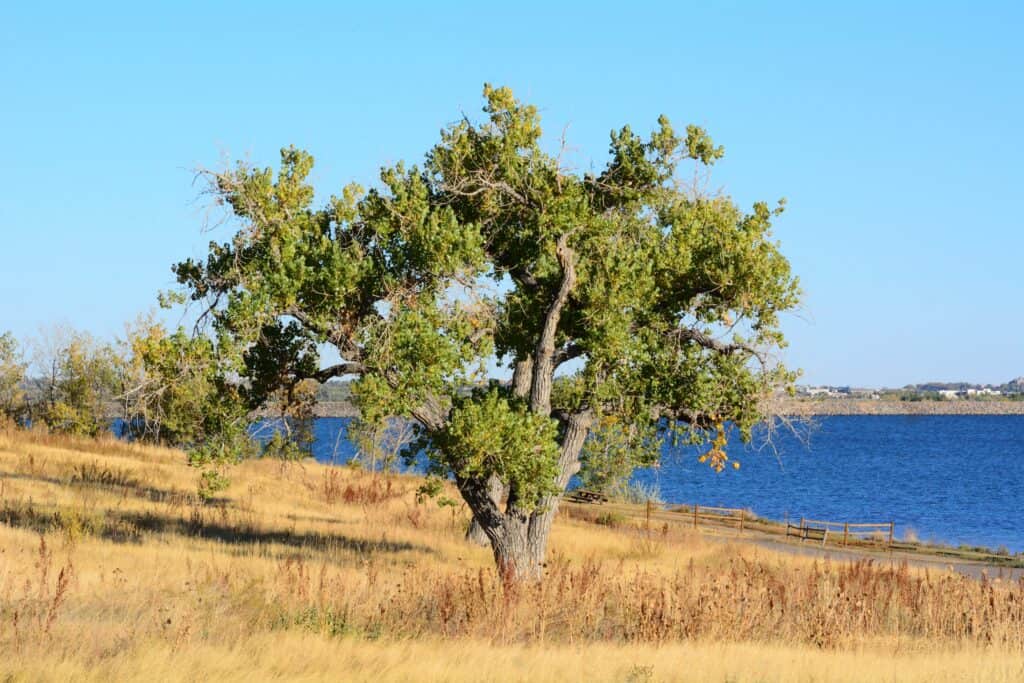
Eastern cottonwood trees smell like balsam.
©Merrimon Crawford/Shutterstock.com
10. Northern Catalpa
The Georgia native tree is best known for its glorious clusters of trumpet-shaped white flowers in spring. In summer, these pollinator magnets develop yellow stripes and sometimes lilac freckles. In fall, a northern catalpa’s flowers mature into 20-inch long seed pods. Some folk call it the Indian cigar tree due to the pod shape.
Providing an attractive background to these distinctive flowers are pale green heart-shaped leaves with a glossy top and fluffy underside. This iconic tree grows in zones 4-8 and reaches 70 feet tall if positioned in moist, loamy soil.
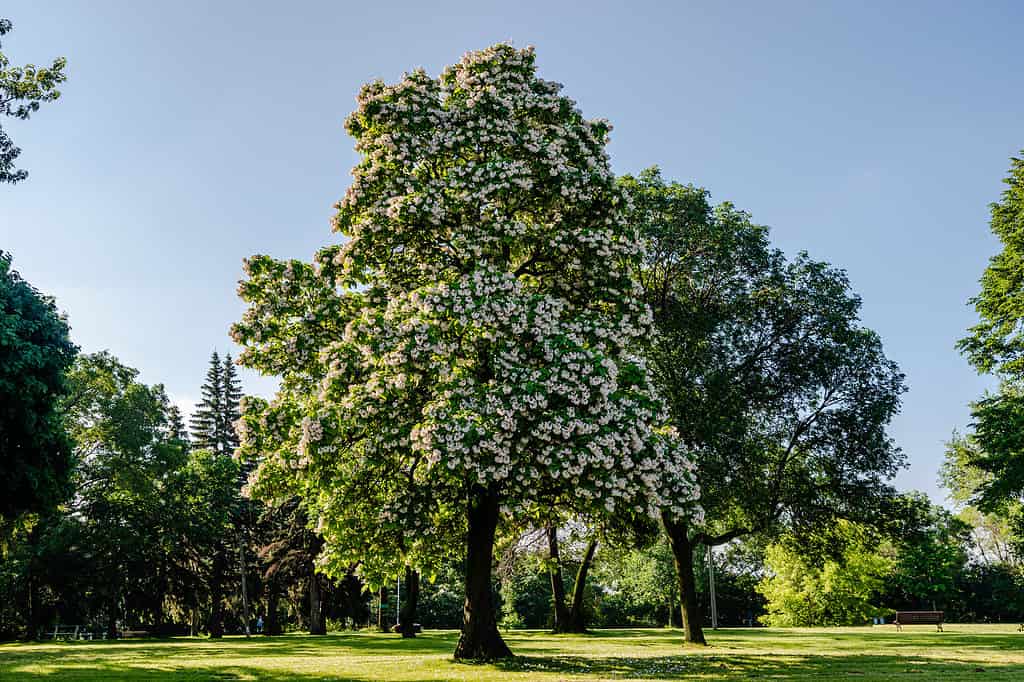
Northern catalpa develop s large pollinator-attracting white flowers in spring.
©iStock.com/Pito Fotos
11. Red Maple
50-foot-tall red maple is iconic because it’s one of the most common maples found in Georgia and across the eastern United States 6b to 8b growing zones.
This deciduous tree has light gray bark, and clusters of small red flowers bloom in February before its lobed foliage unfurls. Flowers mature into small, winged fruits by March.
Red maples like wet areas near river banks, streams, and low-lying depressions but need hot sun on their crowns. It’s a good contender for sunny yards if it’s well-watered. Wild red maples are usually called swamp or water maples due to their water-loving ways.
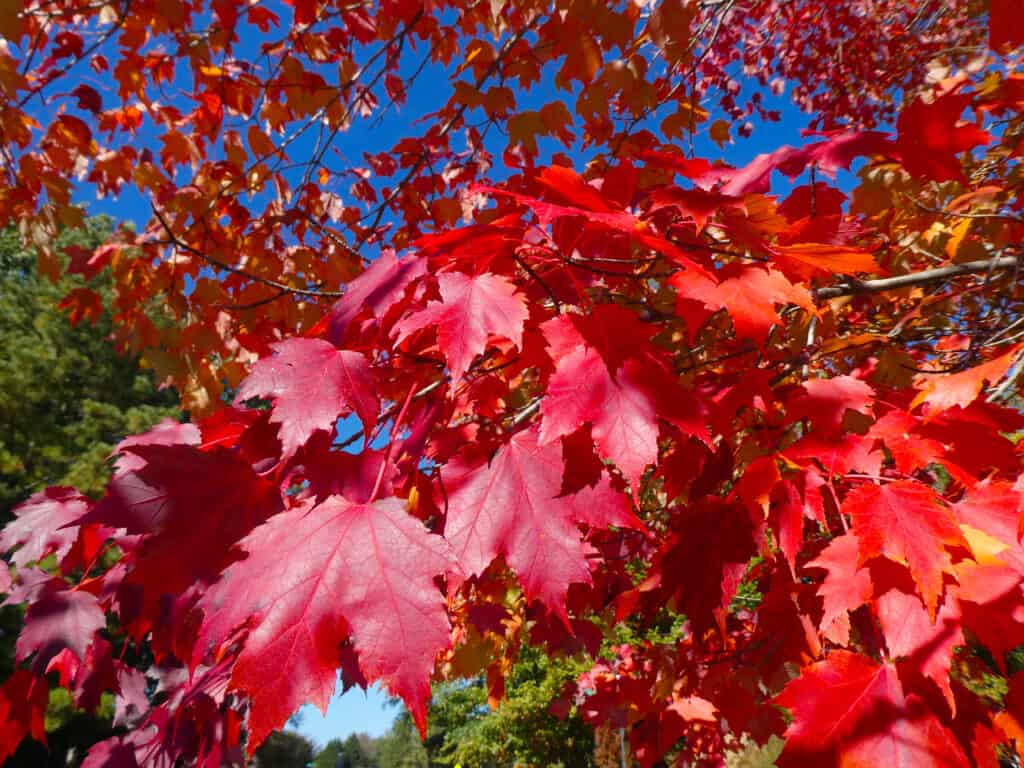
Red maple is a common North American deciduous tree.
©ForestSeasons/Shutterstock.com
12. Dahoon
This Georgia native is a holly relative that reaches 30 feet in zones 7-11. It’s an evergreen that loves the damp soil of wetlands and swamps, but it’s also tough enough to cope with pollution and salt-laden wind.
To bloom, a male and female dahoon need to grow nearby. May to June’s small white flowers mature into tell-tale orange-red berries that birds and mammals adore. This is a wildlife-friendly tree that feeds Georgia’s animals in fall and into winter.
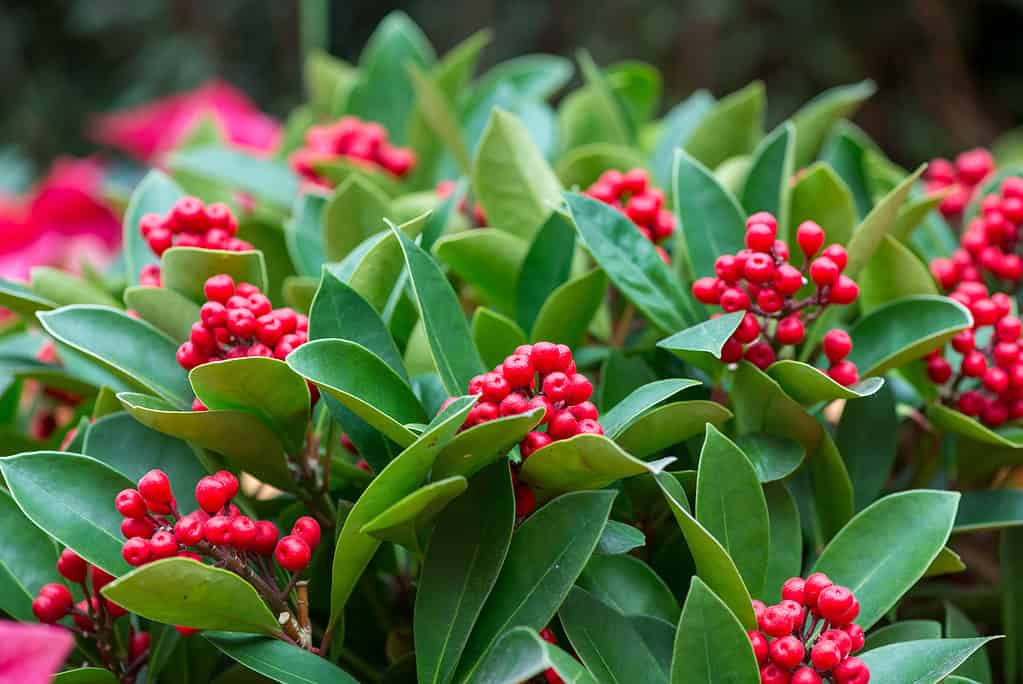
Dahoon trees develop small clusters of red berries that feed birds all winter.
©SubstanceTproductions/Shutterstock.com
13. Water Oak
True to its name, the water oak likes a marshy environment, but it also grows water-drop-shaped leathery green leaves on its wide, rounded crown. In fall, its leaves turn yellow and drop in piles.
Native to the southeastern United States, this is an instantly recognizable, deciduous tree that reaches 100 feet tall in growing zones 5-9. As well as damp soil, it prefers shade and produces golden-yellow catkins in May. When mature, its nuts feed white-tailed deer, squirrels, wood ducks, and quail.
Water oak’s many names, including possum oak, punk oak, duck oak, and spotted oak.
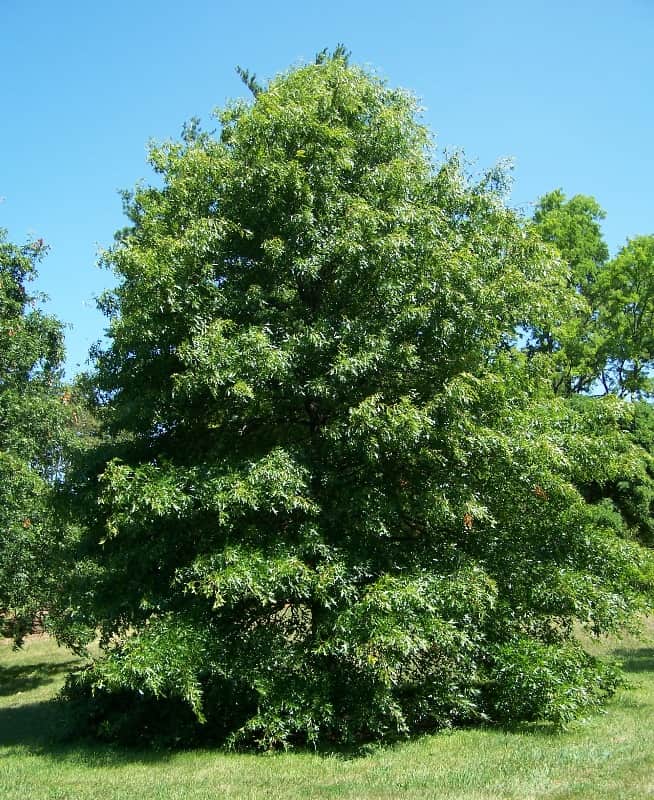
Water oaks have teardrop shaped leaves and love marshy soil.
14. Black Willow
It sounds like an “Avengers” tree, but this 80-foot-tall Georgia native isn’t dangerous.
Its wide range spreads across Georgia’s streams and lakes, giving rise to its other common name, the swamp willow. Black willows’ sturdy root systems prevent bank collapse in rainy conditions, so maybe it is a superhero tree, after all.
Black willows proliferate and produce several crowns from a single trunk. Narrow five-inch-long leaves and vivid green catkins cover its dark gray, deeply fissured bark.

Black willow trees grow alongside marshes, swamps, and rivers.
©Sue Burton Photography/Shutterstock.com
15. Hickory Pine
Hickory pine, prickly pine, or table mountain pine, whatever you call it, this distinctive 40-foot-tall native tree grows on mountain ridges and dry slopes across Georgia’s 5-7 zones.
This attractive tree has a short, thick, crooked trunk with low horizontal branches to fight the wind. Its needles reach two inches long and grow in up to three bunches.
Table mountain pine produces very odd cones. They’re wonky, egg-shaped affairs with glossy scales and lopsided spines. Everything is lopsided about this tree. It’s a contender for a Disney animation!
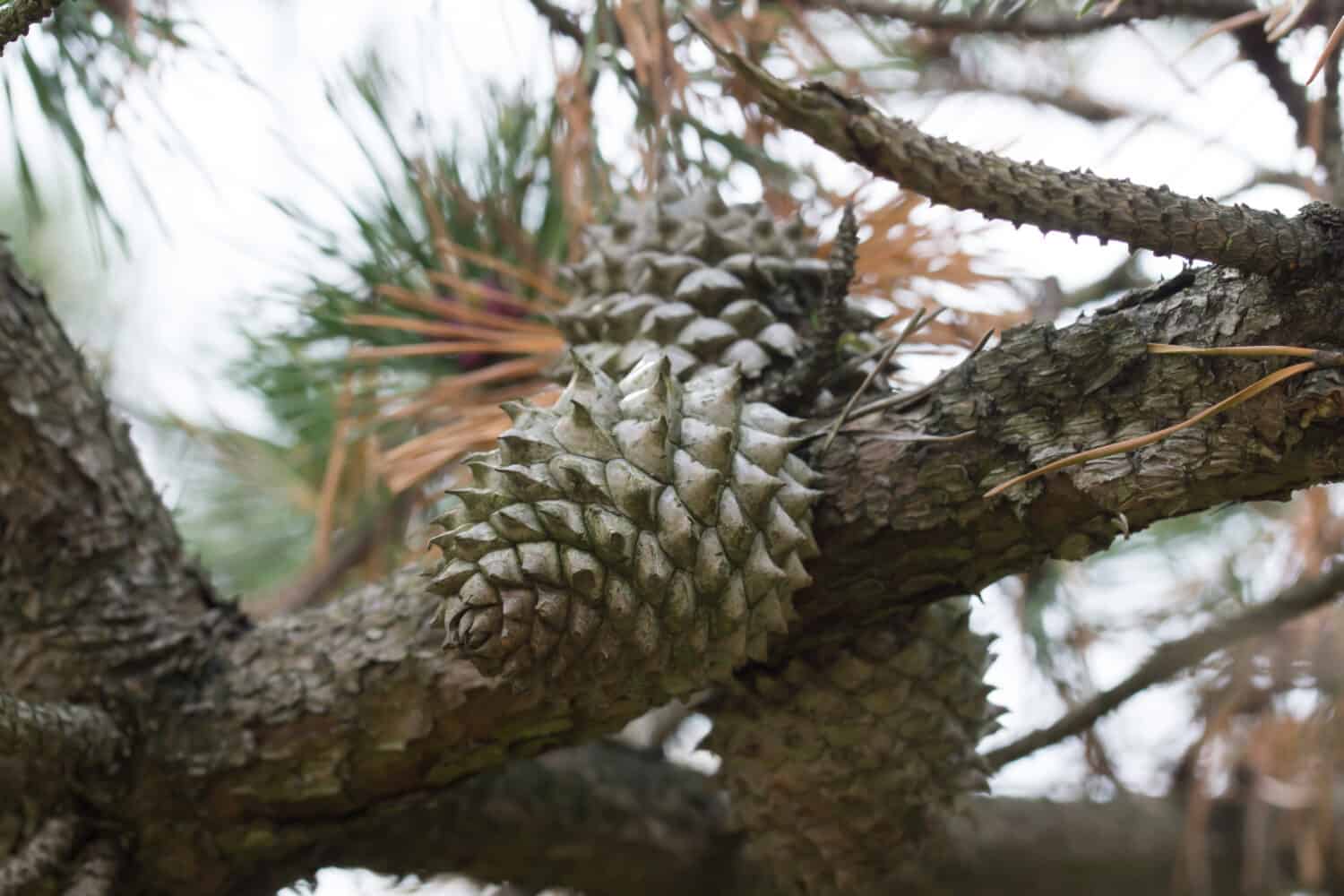
Egg-shaped hickory pine cones grow in haphazard directions.
©A.Luna/Shutterstock.com
16. Yellow Buckeye
Densely foliaged deciduous yellow buckeye gets its name from its glorious display of yellow spring flowers that sit upright in erect seven-inch tall clusters. If pollinated, they mature into smooth brown fruits.
Georgia’s wild yellow buckeye grows in zones 3-8 and reaches 50-80 feet tall. It copes with dry and damp conditions to create a shady ecosystem beneath its wide-spreading canopy. This tree towers above others in a forested environment and scatters the soil with yellow-orange foliage in fall.

Yellow buckeye trees produce seven-inch-tall flower clusters. Bees love them!
©Gerry Bishop/Shutterstock.com
17. Sweetleaf
Horse sugar, wild laurel, and yellow wood all refer to this beautiful 35-foot-tall deciduous sweetleaf tree.
This Georgia native has attractive early spring flowers that bloom before its leaves emerge on branch tips. Its flowers are spectacular, appearing in cream-colored clusters and releasing a sweet honey scent into its woodland habitats. It’s easy to recognize the sweetleaf’s bloom because the stamens protrude further than its petals.
This tree is a big hit with white-tailed deer, which is why it’s named sweetleaf. It grows in zones 7-9 on moist, sandy soils in partial shade.
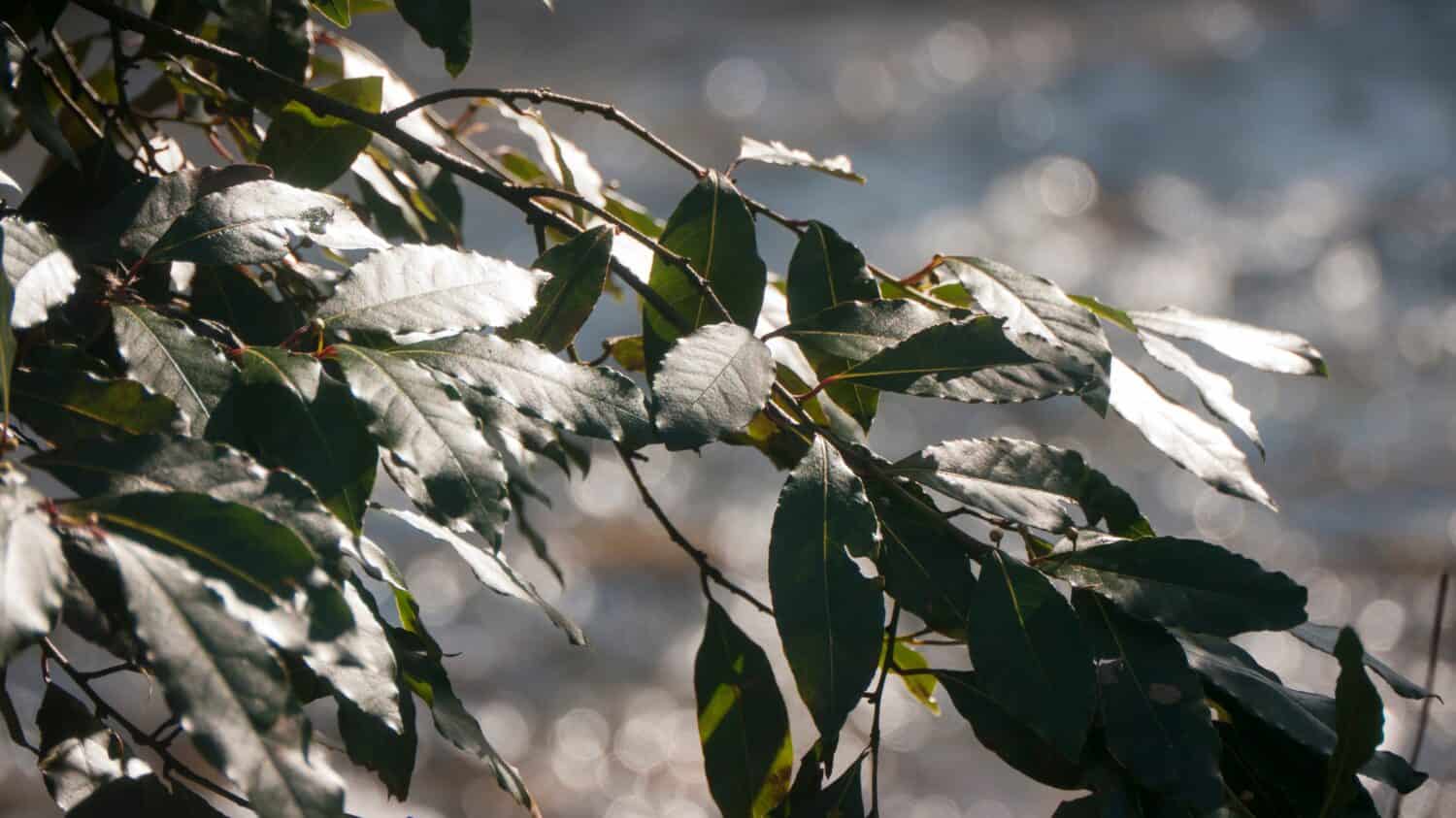
Sweetleaf is also known as the horse sugar tree, wild laurel, and yellow wood.
©Dario Pena/Shutterstock.com
18. American Sycamore
Crooked American sycamore has many names:
- Eastern sycamore
- American plane tree
- Buttonwood
- Western plane tree
It’s a wide canopied deciduous tree with exfoliating gray bark that peels away to reveal pale white bark beneath. Mature American sycamore trunks are mottled with gray, brown, and yellow patches.
This native sycamore loves moist, rich soil in zones 6b to 8b and often grows alongside streams in the wild. It quickly reaches 75-100 feet tall and produces a wide crown of ovate, pointed green leaves all summer long. In winter, distinctive sticky green buds provide interest.
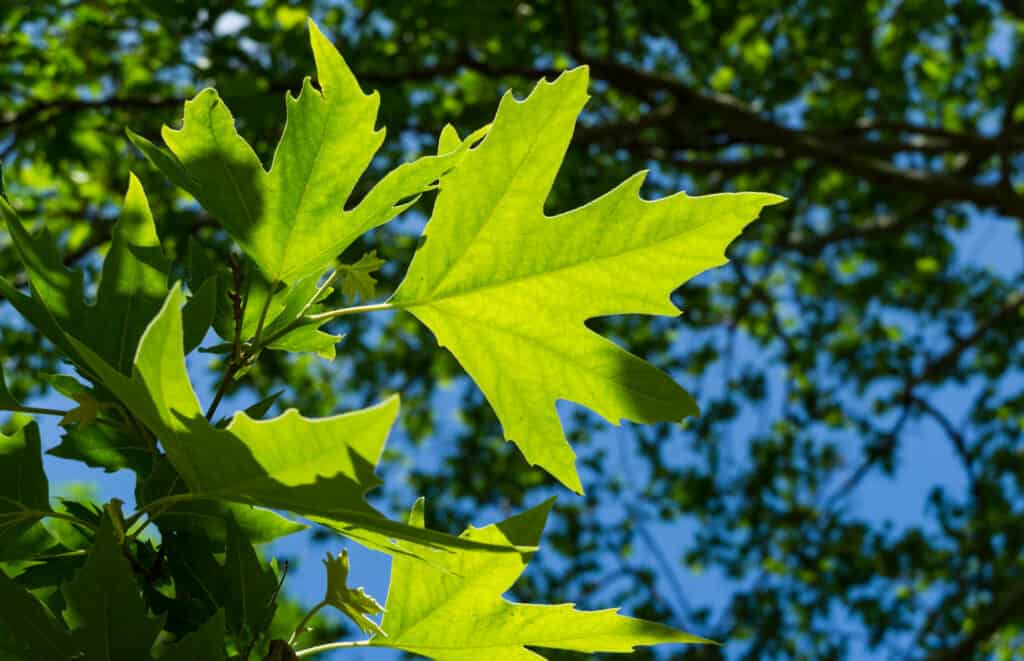
American sycamore tree leaves are bright lime green in spring but mature to yellow and red by fall.
©iStock.com/Marina Denisenko
19. American Elderberry
This small 9-12-foot-tall elderberry tree is native to North America and parts of South America. It prefers damp conditions alongside wetlands, marshes, and streams in zones 3-9.
Its iconic white elderflowers bloom in thick clusters and mature into tiny deep purple fruits, which birds and winemakers love. In some areas, the American elderberry’s habit of spreading via suckers makes it invasive, but this is a wetland icon and a real boon to wildlife that feasts on its nectar and berries for months.
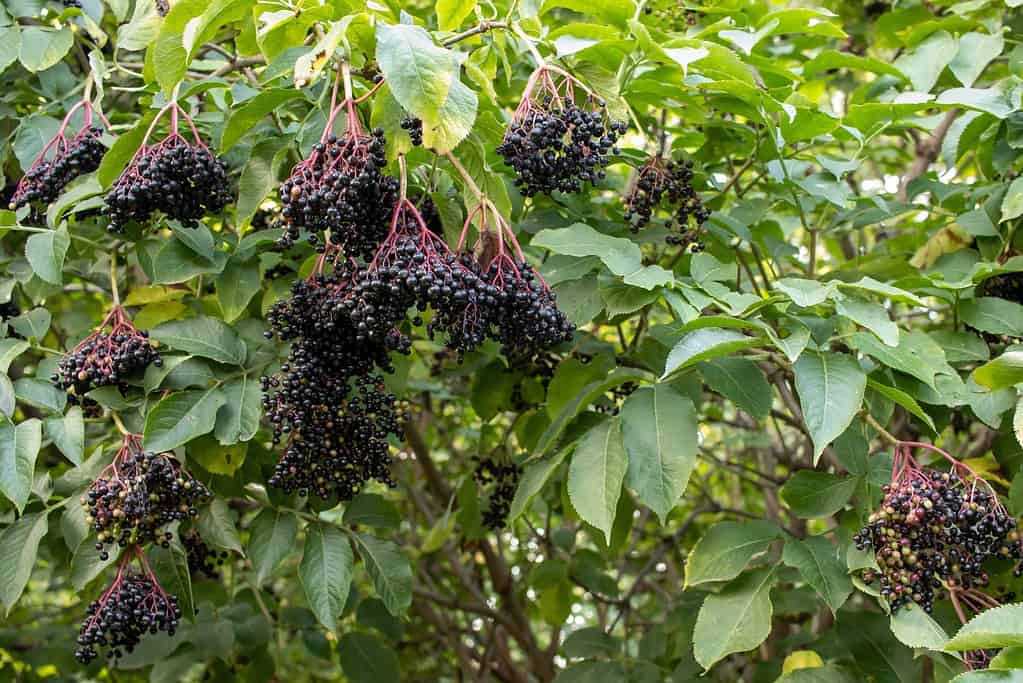
Elderberry trees are great source of nutrition for pollinators, birds, and winemakers.
©Juver/Shutterstock.com
20. Eastern Red Cedar
Aromatic 50-feet-tall eastern red cedar is native to Georgia’s dry and rocky soils. They’re often found in abandoned floodplains, hillsides, and farm fields, soaking up the sunshine. This tree does not like shade!
This tree gets the name “red” from its reddish-gray bark that peels off in foot-long strips. As well as its unusual bark, eastern red cedar has scaly green leaves that overlap on a columnar crown. A strong grower in a fairly limited range of zone 7a to 8b, it’s often called Virginian juniper and used in large yards to create shade.
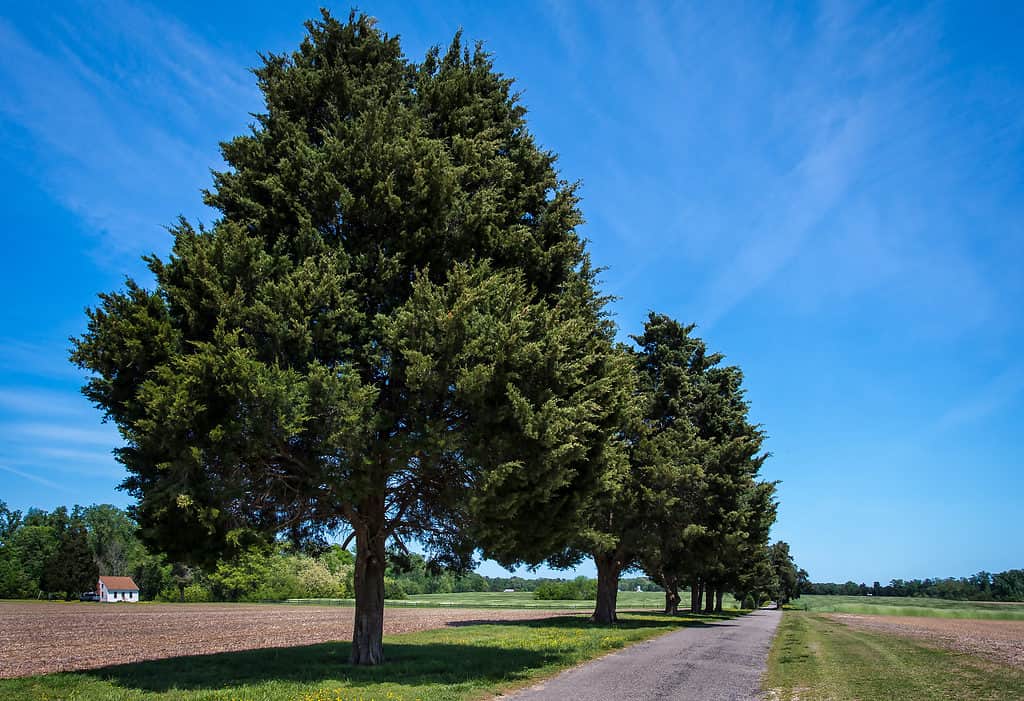
Eastern red cedar trees love direct sunshine and won’t grow in deep shade.
©Gerry Bishop/Shutterstock.com
21. Pepperbark
The evergreen pepperbark tree has a long list of alternative names:
- Hercules club
- Toothache tree
- Tickle tongue
- Prickly ash
It’s a 30-foot-tall spiny tree with a rounded crown of branches set with up to 19 pointed leaflets. Distinctive knobbly gray bark covered in corky lenticels sets this tree apart from other nearby sun-loving trees. Pepperbark prefers to grow wild in zone 7-9’s sunny meadows, prairies, pastures, and forests in well-drained loamy to sandy soil.
It gets the name “toothache tree” from an old recipe. Its ground-up leaves and bark were said to cure toothache.
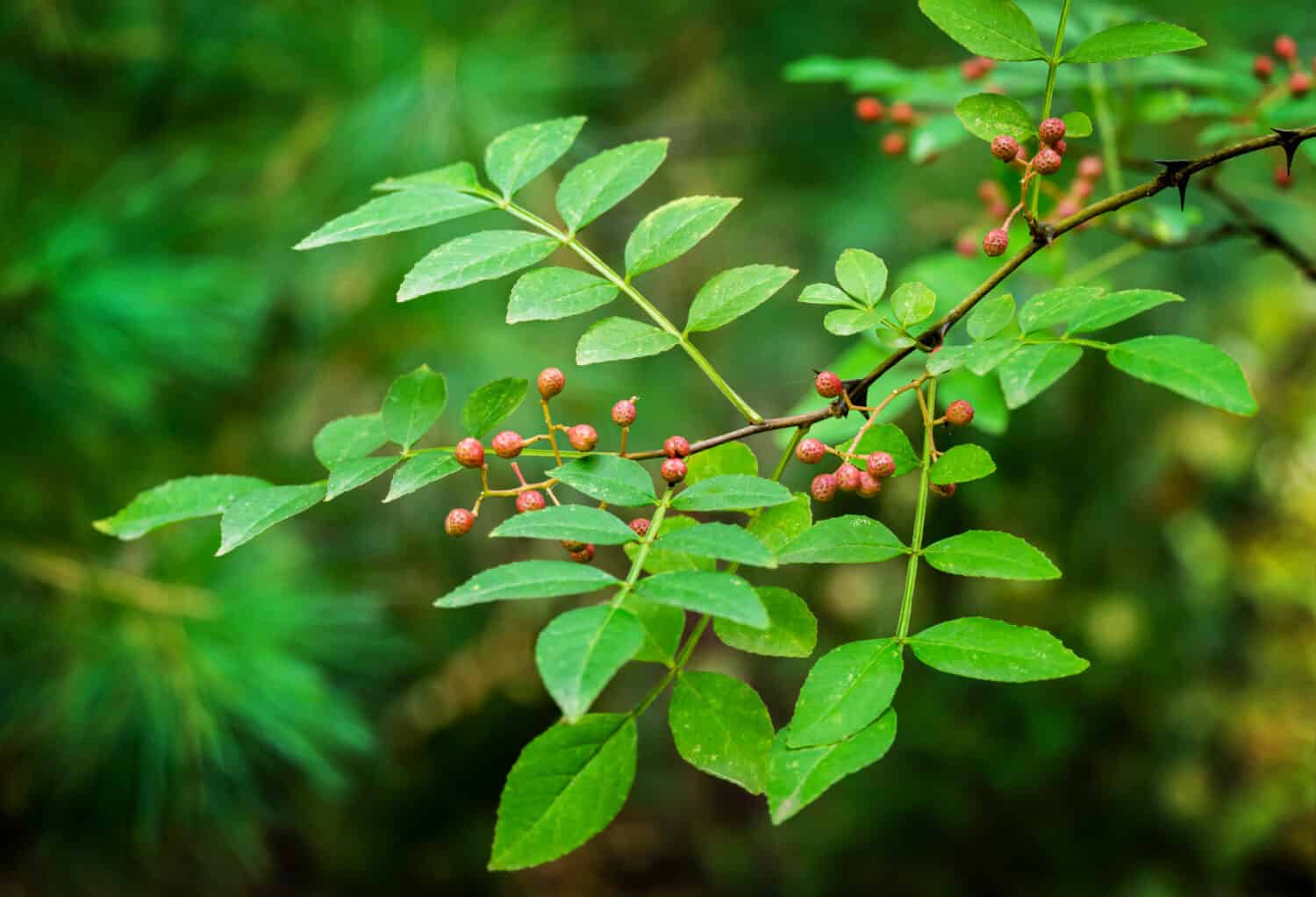
Ground up pepperbark tree leaves is a traditional toothache cure.
©Marinodenisenko/Shutterstock.com
22. Hornbeam
Georgia’s iconic hornbeams show off fluted blue-gray bark in winter and purple-serrated leaves in spring. It’s difficult to mistake this beauty that reaches 30 feet tall in Georgia, but you might hear it called blue beech, musclewood, or ironwood due to its coloring and sturdy timber.
Hornbeam produces wildlife-friendly nutlets in fall that are popular with eastern gray squirrels, and it grows in a wide variety of situations, from wet to dry soil in the shade or sun. It’s a thorny native tree that thrives on whatever life throws at it. A real Georgia native!

American hornbeams are also called blue beech, ironwood, and musclewood.
©Gerry Bishop/Shutterstock.com
23. Sourwood
Deciduous, slow-growing sourwood thrives in Georgia’s zones 5-9 and reaches 30-feet-tall by 30-feet-wide in optimal conditions.
This is an interesting native tree because it produces a pyramidal shape with an oblong crown on a deep gray fissured trunk. Its glossy green leaves emerge before its white lily-of-the-valley pollinator magnet flowers in late spring. In fall, its leaves turn deep red.
Sourwood trees cope with moist and dry soils and make excellent specimen trees in large yards. You might call yours the sorrel tree.
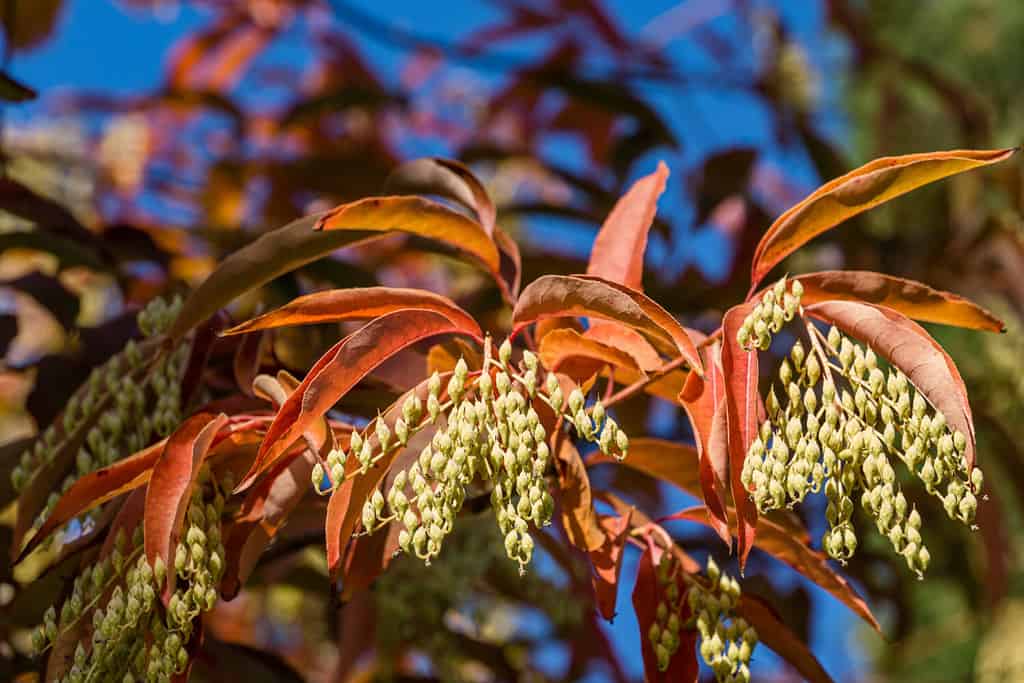
Sourwood’s lily-of-the-valley style flowers are pollinator magnets.
©Marinodenisenko/Shutterstock.com
24. Green Ash
Georgia’s native green ash (confusingly also called red ash!) grows in damp conditions, preferring woodland, riverbanks, swamps, marshes, and land dips. It’s one of Georgia’s most widespread ash species and iconic for its slightly different leaf shape as its spreads across the state.
Pyramidal young trees risk defoliation from white-tailed deer, but mature green ash holds its foliage upright on dark gray branches. Its deer-attracting leaves reach eight inches long and hang in up to nine leaflets with serrated teeth and pointed tips. It can reach 70 feet tall and 50 feet wide in the wild in damp, loamy soil.
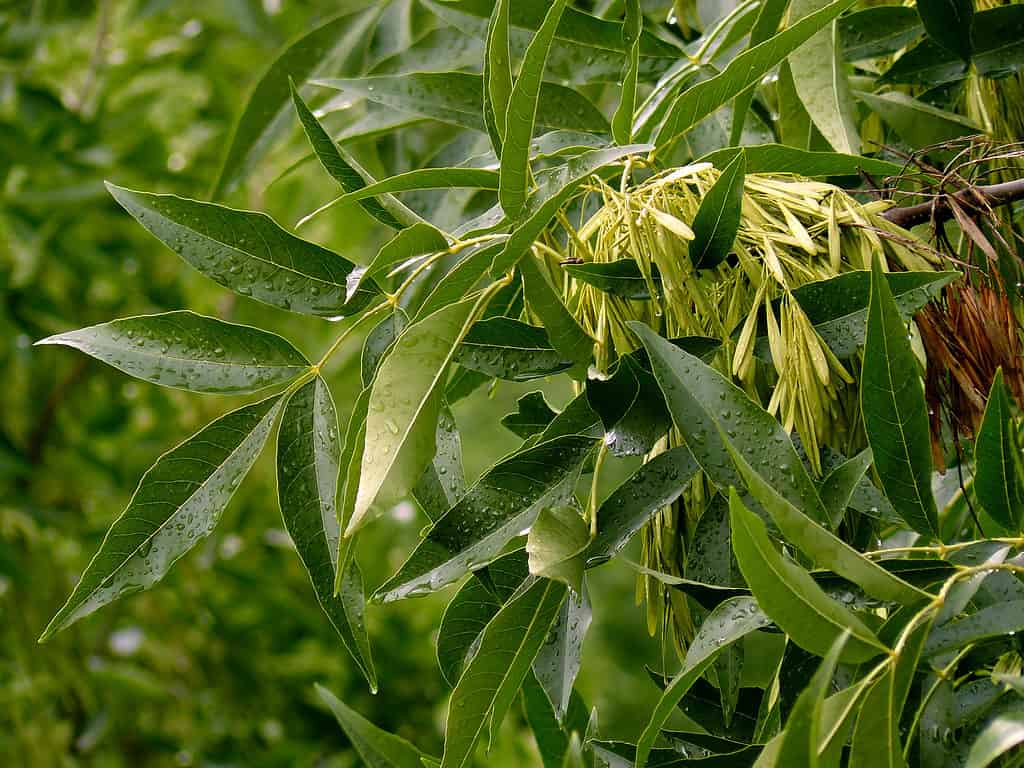
Green ash is one of Georgia’s most wide-spread trees. Deer enjoy eating its foliage.
©Denis Pogostin/Shutterstock.com
25. Honeylocust
North American native honeylocusts thrive in Georgia’s zones 4-8 in moist, marshy areas and river valleys. It’s deciduous and highly adaptable, so outside its native range, it may be invasive.
This fast-growing Georgia tree reaches 80 feet in height and is spread with an airy crown of eight-inch-long pinnate leaves. Its crown only casts partial shade, so other plants thrive beneath its shelter.
Its adaptable nature gives it a foothold in both dry and wet soils, plus it’s tolerant of salt-laden wind, pollution, and harsh winds. To prevent browsers from striping their foliage, the honeylocust has four-inch long thorns on its branches that turn red with age, hence its other common name, “thorny locust.”
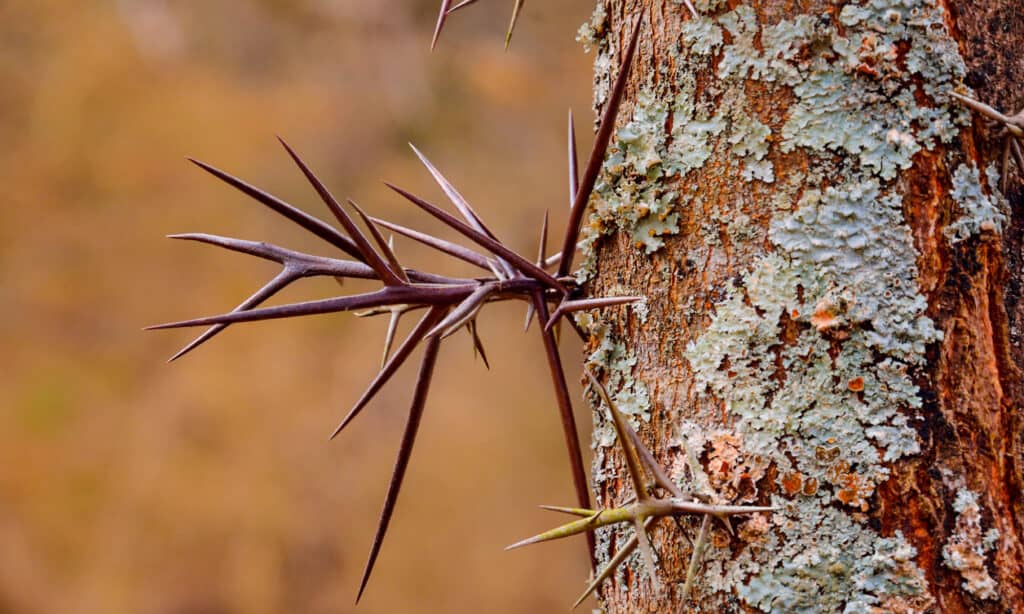
Honeylocust trees develop large thorns to deter grazing mammals like deer.
©damann/Shutterstock.com
26. Allegheny Chinquapin
Thicket-forming deciduous allegheny chinquapin is a dwarf chestnut species native to Georgia. Its annual harvest of nutrient-packed chestnuts is a bounty for deer, squirrels, and animals in Georgia’s woodlands.
This tasty chestnut prefers sandy, dry soil and tends to grow near ridges and rocky upland woods in full sun. Before its prickly-cased chestnuts mature, large pale-yellow spikes of pollinator-magnet flowers bloom in abundance on horizontal branch tips amid toothed, glossy green foliage.

Sweet chestnuts feed a wide range of wild animals including white-tailed deer, squirrels, and wild pigs.
©ChWeiss/Shutterstock.com
27. Big Leafed Magnolia
An iconic 40-foot-tall Georgia native, the deciduous bigleaf magnolia produces 36-inch-long green leaves with a silvery underside. Its epic leaves emerge in late spring on a wide crown, and not much later, its spectacular flower show begins.
Big leafed magnolia has scented 10-inch-wide white flowers with a purple base. Pollinators like hummingbirds love its easily accessed nectar. When pollinated, the flowers mature into egg-shaped, red-seeded fruits.

Bigleaf magnolia flowers reach 10-inches-wide and attract hummingbirds.
©Nikolay Kurzenko/Shutterstock.com
28. Virginia Witch Hazel
Deciduous Virginia witch hazel isn’t just native to Virginia; it thrives in Georgia’s zones 4-8, where it reaches 20-feet-tall. It’s best known for its pollinator-attracting scented yellow flowers, which persist until December, even after the green foliage has turned yellow and fallen. In early fall, this woodland icon glows golden-yellow.
It prefers full sun and well-drained soil on deciduous woodland edges.
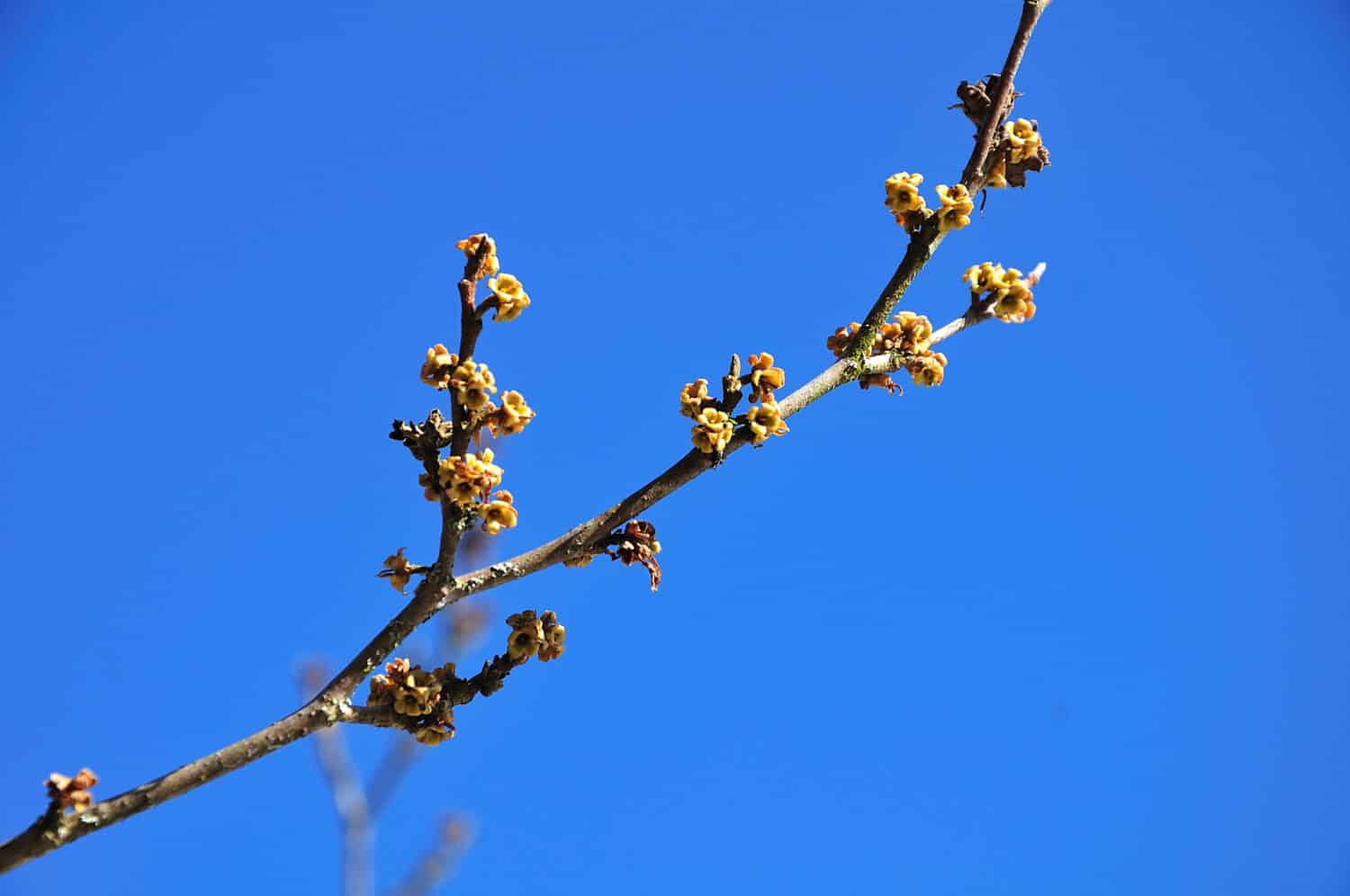
Virginia witch hazel’s yellow flowers bloom in winter.
©Carmen Hauser/Shutterstock.com
29. Pignut Hickory
Native pignut hickory trees grow to a maximum of 65 feet tall in zones 5-9, but their branches droop, which makes them appear smaller.
Pignut hickory has scaly ridged bark and compound pinnate leaves shaped like a hand. The name “pignut” is self-explanatory, but these pear-shaped nuts are not tasty to many creatures and usually eaten as a last resort. When they fall, the nuts lay on the ground, only splitting open into four segments when temperatures are optimal for quick growth. Usually, this is humid September to October months.
Preferring well-drained soil in open areas, this is an iconic tree on Georgia’s woodland edges and indicative of a thriving ecosystem within.

Pignut hickory produces pear-shaped nuts that feed many wild animals in the fall.
30. Black Walnut
North America’s deciduous native black walnut trees thrive in Georgia’s varied climate. It’s one of the most abundant trees there.
Its deep brown wood is highly sought after, and its seeds, known as walnuts, are tasty to humans and wild mammals. Black walnut trees take ten years to start producing nuts in the wild.
This tree has a spicy scent and reaches 100 feet tall on a straight gray-black trunk with a distinctive diamond pattern. Its broad crown holds pinnately compound alternate green leaves with a serrated edge and pointed tip.
Black walnut trees excellent timber, nuts, and tough growth habits easily translated into profit. European countries began to import them in 1629.
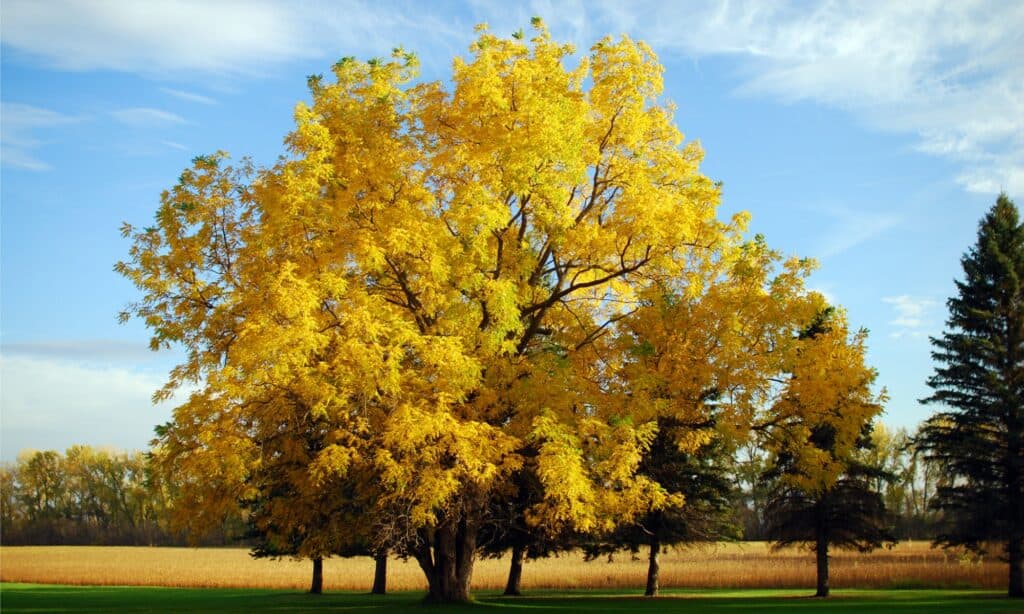
Black walnut trees are native to Georgia but were introduced to Europe in the 1600s.
©iStock.com/jdt01fgo
31. Sparkleberry
Let’s finish up our list of iconic trees native to Georgia, with the handsome sparkleberry tree that gets its name from its glistening fruit.
This attractive deciduous tree reaches a maximum of 25 feet tall with a stout trunk and irregular crown of dark green leaves that mature to deep red in fall. In spring, fragrant white bell flowers attract clouds of pollinators and ripen into shiny black berries for the birds.
Sparkleberry grows wild in zone 6-9 woodlands, along river banks, and in well-drained sandy sites across Georgia. Some folks call it the fackleberry, but this is most likely a mis-spelling of sparkleberry written in cursive hundreds of years ago.

Georgia native sparkleberry is also known as fackleberry, due to a mis-spelling.
©Donna Bollenbach/Shutterstock.com
The photo featured at the top of this post is © Sean Pavone/Shutterstock.com
Thank you for reading! Have some feedback for us? Contact the AZ Animals editorial team.







